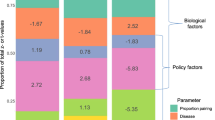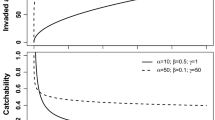Abstract
Management of endangered species requires methods to assess the effects of strategies, providing a basis for deciding on a best course of action. An important component of assessment is population viability analysis (PVA). The latter may be formally implemented through decision analysis (DA). These methods are most useful for conservation when used in conjunction. In this paper we outline the objectives and the potential of both frameworks and their overlaps. Both are particularly helpful when dealing with uncertainty. A major problem for conservation decision-making is the interpretation of observations and scientific measurements. This paper considers probabilistic and non-probabilistic approaches to assessment and decision-making and recommends appropriate contexts for alternative approaches.
Similar content being viewed by others
References
Akçakaya H.R. and Atwood J.L. 1997. A habitat-based metapopulation model of the California Gnatcatcher. Conservation Biology 11: 422-434.
Akçakaya H.R., Burgman M.A. and Ginzburg L. 1999. Applied Population Ecology. Sinauer Associates, Sunderland, Massachusetts.
Akçakaya H.R., Ferson S., Burgman M.A., Keith D.A., Mace G.M. and Todd C.R. 2000. Making consistent IUCN classifications under uncertainty. Conservation Biology 14: 1001-1013.
Anderson J.L. 1998. Embracing uncertainty: the interface of Bayesian statistics and cognitive psychology. Conservation Ecology [online] 2(1): 2. URL: http://www.consecol.org/vol2/iss1/art2
Bakan D. 1960. The test of significance in psychological research. Psychological Bulletin 66: 423-437.
Bana e Costa C.A. 1990. (ed), Readings in Multiple Criteria Decision Aid. Springer, Berlin, Germany.
Boyce M.S. 1992. Population viability analysis. Annual Review of Ecology and Systematics 23: 481-506.
Breininger D.R., Burgman M.A., Akçakaya H.R. and O'Connell M.A. 2002. Use of metapopulations in conservation planning. In: Gutzwiller K. (ed), Applying Landscape Ecology in Biological Conservation. Springer, New York, pp. 405-427.
Burgman M.A. 2000. Population viability analysis for bird conservation: theory, practice, models and psychology. Emu 100: 347-353.
Burgman M.A. and Lamont B.B. 1992. A stochastic model for the viability of Banksia cuneata populations: environmental, demographic and genetic effects. Journal of Applied Ecology 29: 719-727.
Burgman M.A., Breininger D.R., Duncan B.W. and Ferson S. 2001. Setting reliability bounds on habitat suitability indices. Ecological Applications 11: 70-78.
Caswell H. 1978. A general formula for the sensitivity of population growth rate to changes in the life history parameters. Theoretical Population Biology 14: 215-230.
Caughley G. 1994. Directions in conservation biology. Journal of Animal Ecology 63: 215-244.
Clemen R.T. 1996. Making Hard Decisions: An Introduction to Decision Analysis. Duxbury, Pacific Grove, California.
Cohen J. 1988. Statistical Power Analysis for the Behavioural Sciences. 2nd edn. Lawrence Erlbaum Associates, Hillsdale, New Jersey.
Cohen J. 1994. The Earth is round (p < 0.05). American Psychologist 12: 997-1003.
Drechsler M. 1998. Sensitivity analysis of complex models. Biological Conservation 86: 401-412.
Drechsler M. 2000. A model-based decision aid for species protection under uncertainty. Biological Conservation 94: 23-30.
Drechsler M. 2004. Model-based conservation decision aiding in the presence of goal conflicts and uncertainty. Biodiversity and Conservation 13: 141-164 (this issue).
Drechsler M. and Wätzold F. 2001. The importance of economic costs in the development of guidelines for spatial conservation management. Biological Conservation 97: 51-59.
Drechsler M., Burgman M.A. and Menkhorst P.W. 1998. Uncertainty in population dynamics and its consequences for the management of the Orange-bellied Parrot Neophema chrysogaster. Biological Conservation 84: 269-281.
Eckhoudt L. and Gollier C. 1995. Risk — Evaluation, Management and Sharing. Harvester and Wheatsheaf, New York/London.
Elith J. 2000. Quantitative methods for modelling species habitat. In: Ferson S. and Burgman M.A. (eds), Quantitative Methods for Conservation Biology. Springer, New York, pp. 39-58.
Fairweather P.G. 1991. Statistical power and design requirements for environmental monitoring. Australian Journal of Marine Freshwater Research 42: 555-567.
Falk R. and Greenbaum C.W. 1995. Significance tests die hard. Theory and Psychology 5: 396-400.
Ferguson I.S. 1996. Sustainable Forest Management. Oxford University Press, Melbourne, Australia.
Fischhoff B., Slovic P. and Lichtenstein S. 1982. Lay foibles and expert fables in judgements about risk. American Statistician 36: 240-255.
Fleming D.M., DeAngelis D.L., Gross L.J., Ulanowicz R.E., Wolff W.F., Loftus W.F. et al. 1994. ATLSS: Across-Trophic-Level System Simulation for the Freshwater Wetlands of the Everglades and Big Cypress Swamp. National Biological Service Technical Report. Washington, DC.
Fox D.R. 2001. Environmental power analysis — a new perspective. Environmetrics 12: 437-449.
Gelman A., Carlin J.B., Stern H.S. and Rubin D.B. 1995. Bayesian Data Analysis. Chapman & Hall, London.
Gill J. 1999. The insignificance of null hypothesis significance testing. Political Research Quarterly 52: 647-674.
Green R.H. 1995. Aspects of power analysis in environmental monitoring. In: Fletcher D.J. and Manly B.J.F. (eds), Statistics in Ecology and Environmental Monitoring. Otago Conference Series No. 2. University of Otago Press, Dunedin, New Zealand, pp. 173-182.
Hanley N. and Spash C.L. 1993. Cost-Benefit Analysis and the Environment (Chapter 1). Edward Elgar, Brookfield, Vermont.
Hilborn R. and Ludwig D. 1993. The Limits of Applied Ecological Research. Ecological Applications 3: 550-552.
Hilborn R. and Walters C.J. 1992. Quantitative Fisheries Stock Assessment: Choice, Dynamics, and Uncertainty. Chapman & Hall, New York.
Howson C. and Urbach P. 1993. Scientific Reasoning. The Bayesian Approach. 2nd edn. Open Court, Chicago, Illinois.
IUCN 1994. IUCN Red List Categories. Species Survival Commission. IUCN, Gland, Switzerland.
Johnson D.H. 1999. The insignificance of statistical significance testing. Journal of Wildlife Management 63: 763-772.
Klepper O. 1997. Multivariate aspects of model uncertainty analysis: tools for sensitivity analysis and calibration. Ecological Modelling 101(1): 1-13.
Ludwig D., Hilborn R. and Walters C. 1993. Uncertainty, resource exploitation, and conservation: lessons from history. Science 260: 17-36.
Macdonald R.R. 1997. On Statistical Testing in Psychology. British Journal of Psychology 88: 333-349.
Maguire L.A. 1986. Using decision analysis to manage endangered species populations. Journal of Environmental Management 22: 345-360.
Mapstone B.D. 1995. Scaleable decision rules for environmental impact studies: effect size, Type I and Type II errors. Ecological Applications 5: 401-410.
Margules C.R. and Nicholls A.O. 1993. Where should nature reserves be located? In: Moritz C. and Kikkawa J. (eds), Conservation Biology in Australia and Oceania. Surrey Beatty & Sons, Chipping Norton, Australia.
May R.M. 1976. Theoretical Ecology. Blackwell, Oxford, UK.
Meehl P.E. 1978. Theoretical risks and tabular asterisks: Sir Karl, Sir Ronald, and the slow progress of soft psychology. Journal of Counseling and Clinical Psychology 46: 806-834.
Morgan M.G. and Henrion M. 1990. Uncertainty: A Guide to Dealing with Uncertainty in Quantitative Risk and Policy Analysis. Cambridge University Press, Cambridge, UK.
Murtaugh P.A. 1996. The statistical evaluation of ecological indicators. Ecological Applications 6: 132-139.
O'Hara R.B., Arjas E., Toivonen H. and Hanski I. 2002. Bayesian analysis of metapopulation data. Ecology 83: 2408-2415.
Peterman R.M. 1990. Statistical power analysis can improve fisheries research and management. Canadian Journal of Fisheries and Aquatic Sciences 47: 2-15.
Portney P.R. and Weyant J.P. (eds), 1999. Discounting and Intergenerational Equity. Resources for the Future, Washington, DC.
Possingham H. 1996. Decision theory and biodiversity management: how to manage a metapopulation. In: Floyd R.B., Sheppard A.W. and De Barro P.J. (eds), Frontiers of Population Ecology. CSIRO Publishing, Melbourne, Australia, pp. 391-398.
Possingham H. and Shea C. 1999. The Business of Biodiversity. Australian Zoologist 31(1): 3-5.
Pressey R.L., Humphries C.J., Margules C.R., Vane-Wright R.I. and Williams P.H. 1993. Beyond opportunism: key principles for systematic reserve selection. TREE 8: 124-128.
Punt A. and Hilborn R. 1997. Fisheries stock assessment and decision analysis: the Bayesian approach. Reviews in Fish Biology and Fisheries 7: 35-63.
Ralls K. and Starfield A.M. 1995. Choosing a management strategy: two structured decisionmaking methods for evaluating the predictions of stochastic simulation models. Conservation Biology 9: 175-181.
Regan H.M., Colyvan M. and Burgman M.A. 2000. A proposal for fuzzy International Union for the Conservation of Nature (IUCN) categories and criteria. Biological Conservation 92: 101-108.
Richards S.A., Possingham H.P. and Tizard J. 1999. Optimal fire management for maintaining community diversity. Ecological Applications 9: 880-892.
Rosenberg A.A., Fogarty M.J., Sissenwine M.P., Beddington J.R. and Shepherd J.G. 1993. Achieving sustainable use of renewable resources. Science 262: 828-829.
Shrader-Frechette K. 1996. Methodological rules for four classes of scientific uncertainty. In: Lemons J. (ed), Scientific Uncertainty and Environmental Problem Solving. Blackwell, Cambridge, Massachusetts, pp. 12-39.
Smith A.D.M., Sainsbury K.J. and Stevens R.A. 1999. Implementing effective fisheriesmanagement systems-management strategy evaluation and the Australian partnership approach. ICES Journal of Marine Science 56: 967-979.
Sokal R.R. and Rohlf F.J. 1995. Biometry. Freeman, San Francisco, California.
Stewart T.J. 1992. A critical survey on the status of multiple criteria decision making-theory and practice. OMEGA International Journal of Management Science 20: 569-586.
Tahvonen O. 1995. Dynamics of pollution control when damage is sensitive to the rate of pollution accumulation. Environmental and Resource Economics 5: 9-27.
Thompson P.M., Wilson B., Grellier K. and Hamond P.S. 2000. Combining power analysis and population viability analysis to compare traditional and precautionary approaches to conservation of coastal cetaceans. Conservation Biology 14: 1253-1263.
Tversky A. and Kahneman D. 1974. Judgement under uncertainty: heuristics and biases. Science 211: 453-458.
Underwood A.J. 1995. Things environmental scientists (and statisticians) need to know to receive (and give) better statistical advice. In: Fletcher D.J. and Manly B.J.F. (eds), Statistics in Ecology and Environmental Monitoring. Otago Conference Series No. 2. University of Otago Press, Dunedin, New Zealand, pp. 33-61.
Wade P.R. 2000. Bayesian methods in conservation biology. Conservation Biology 14: 1308-1316.
Wu J. and Bogess W.G. 1999. The optimal allocation of conservation funds. Journal of Environmental Economics and Management 38: 302-321.
Author information
Authors and Affiliations
Corresponding author
Rights and permissions
About this article
Cite this article
Drechsler, M., Burgman, M.A. Combining Population Viability Analysis with Decision Analysis. Biodiversity and Conservation 13, 115–139 (2004). https://doi.org/10.1023/B:BIOC.0000004315.09433.f6
Issue Date:
DOI: https://doi.org/10.1023/B:BIOC.0000004315.09433.f6




